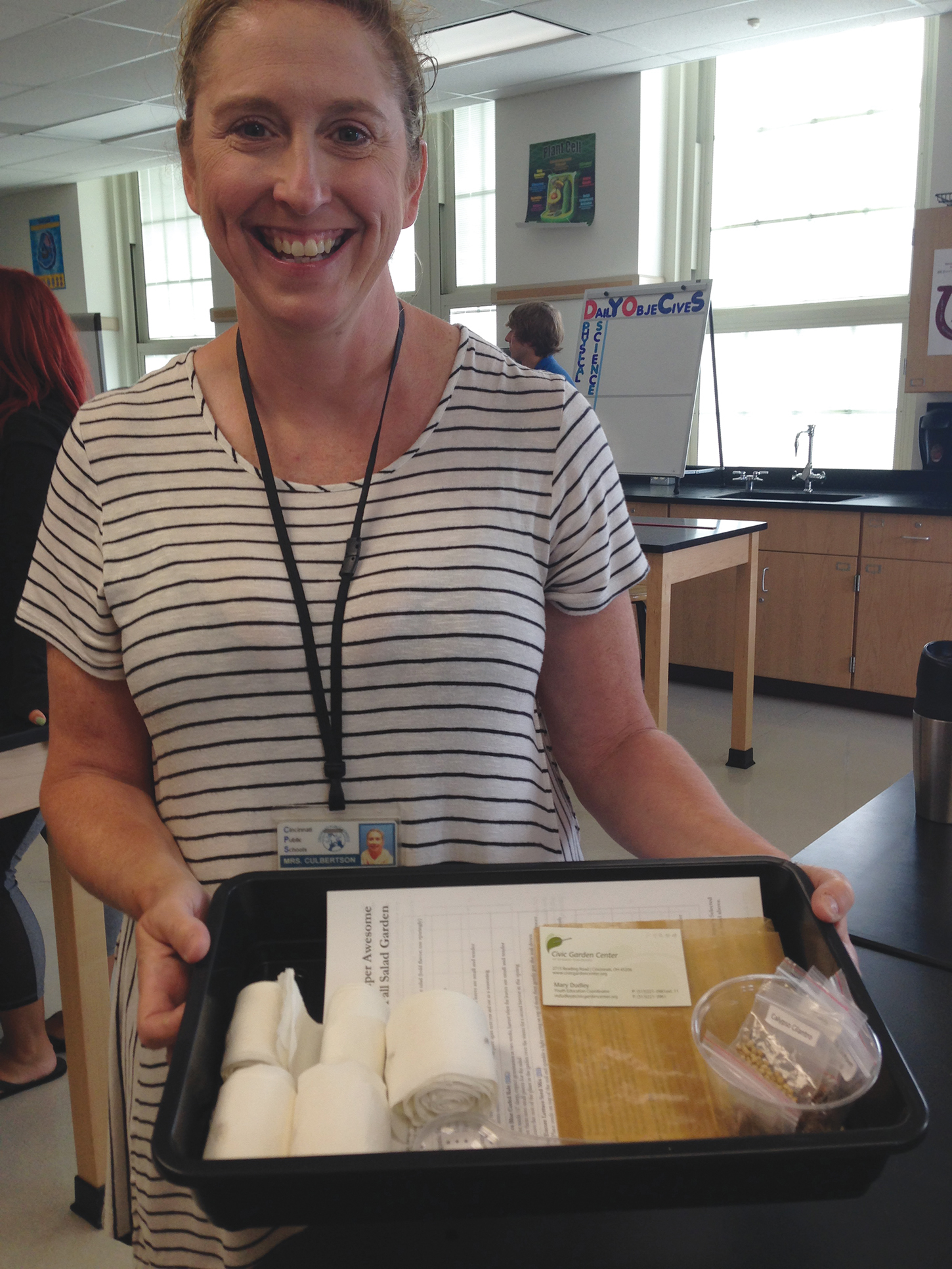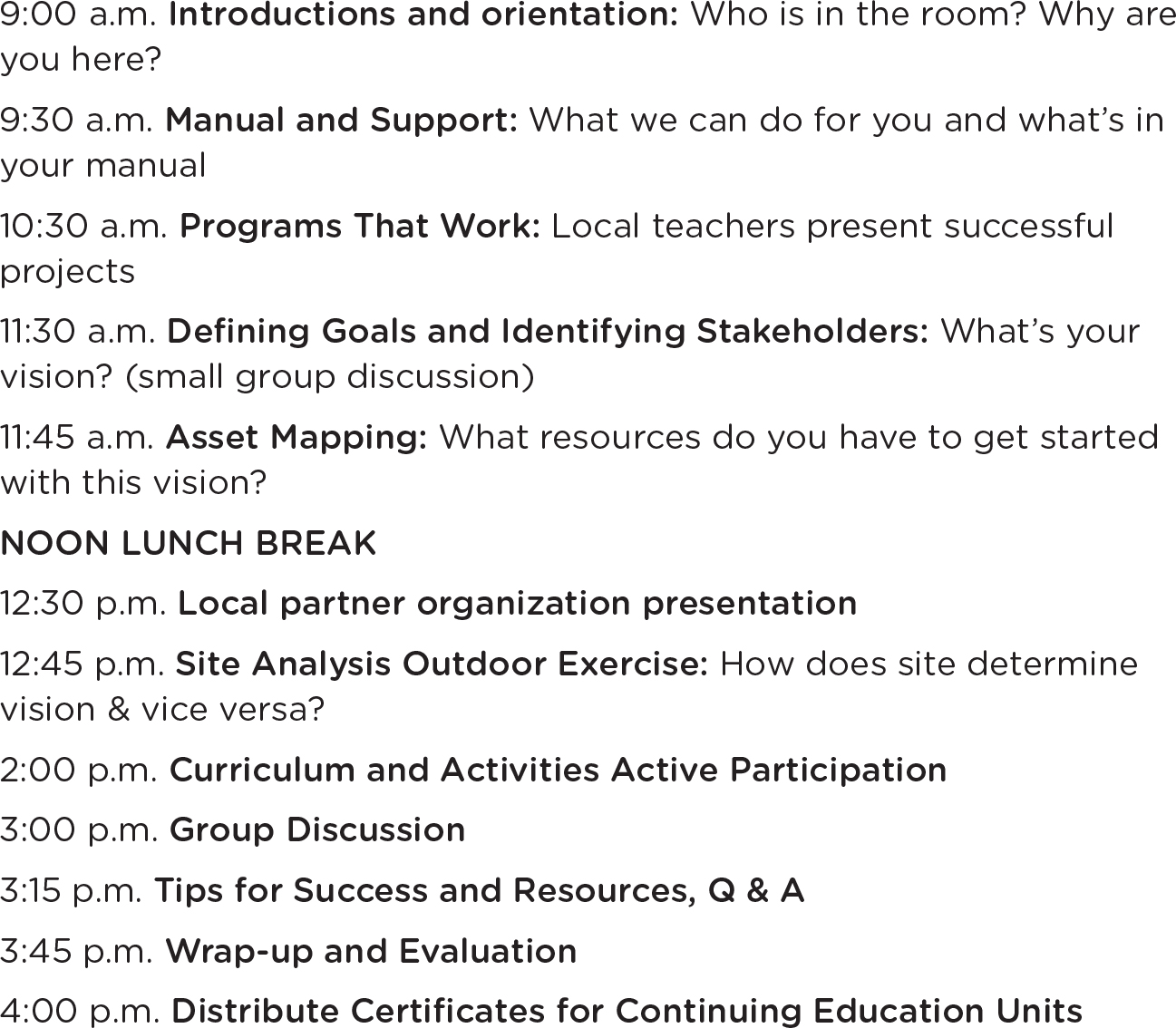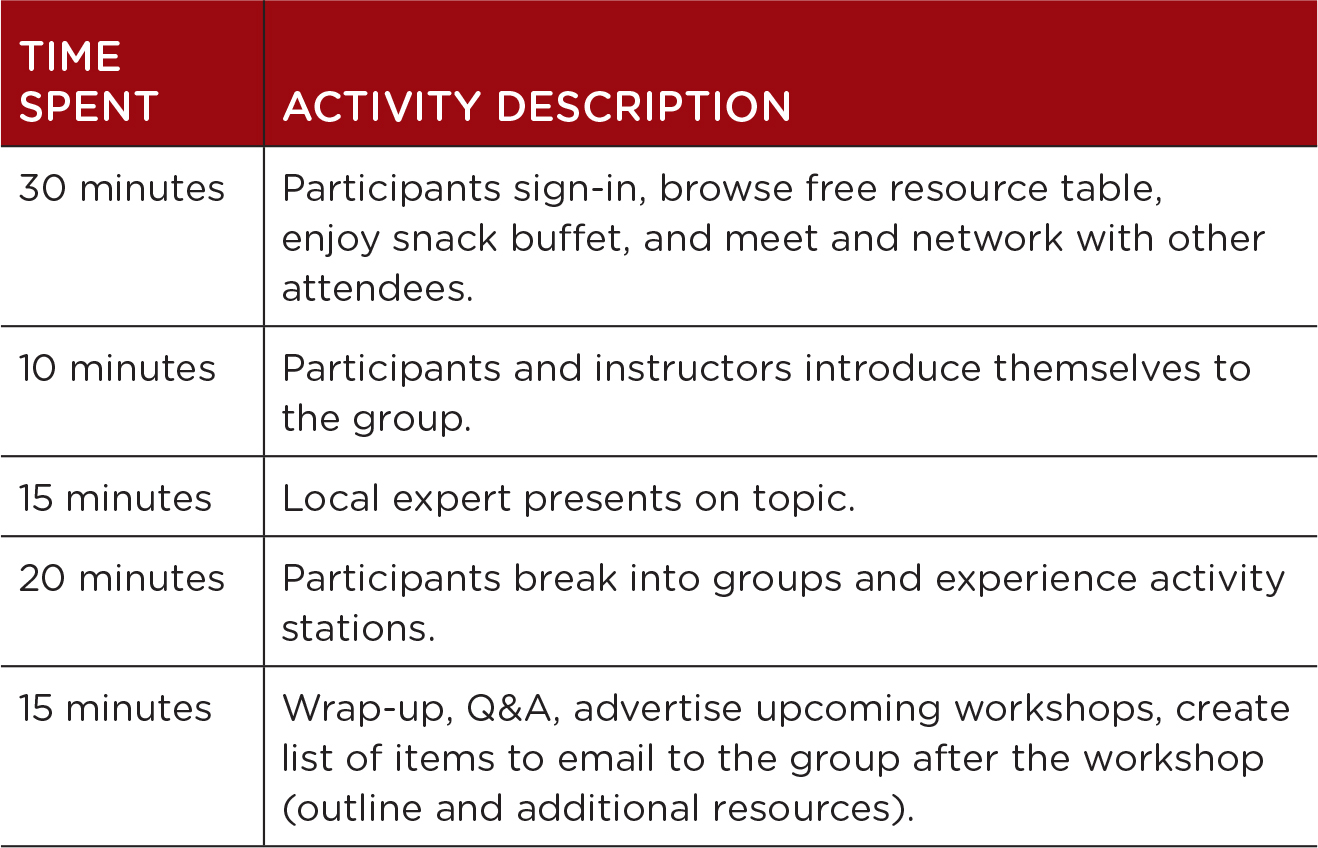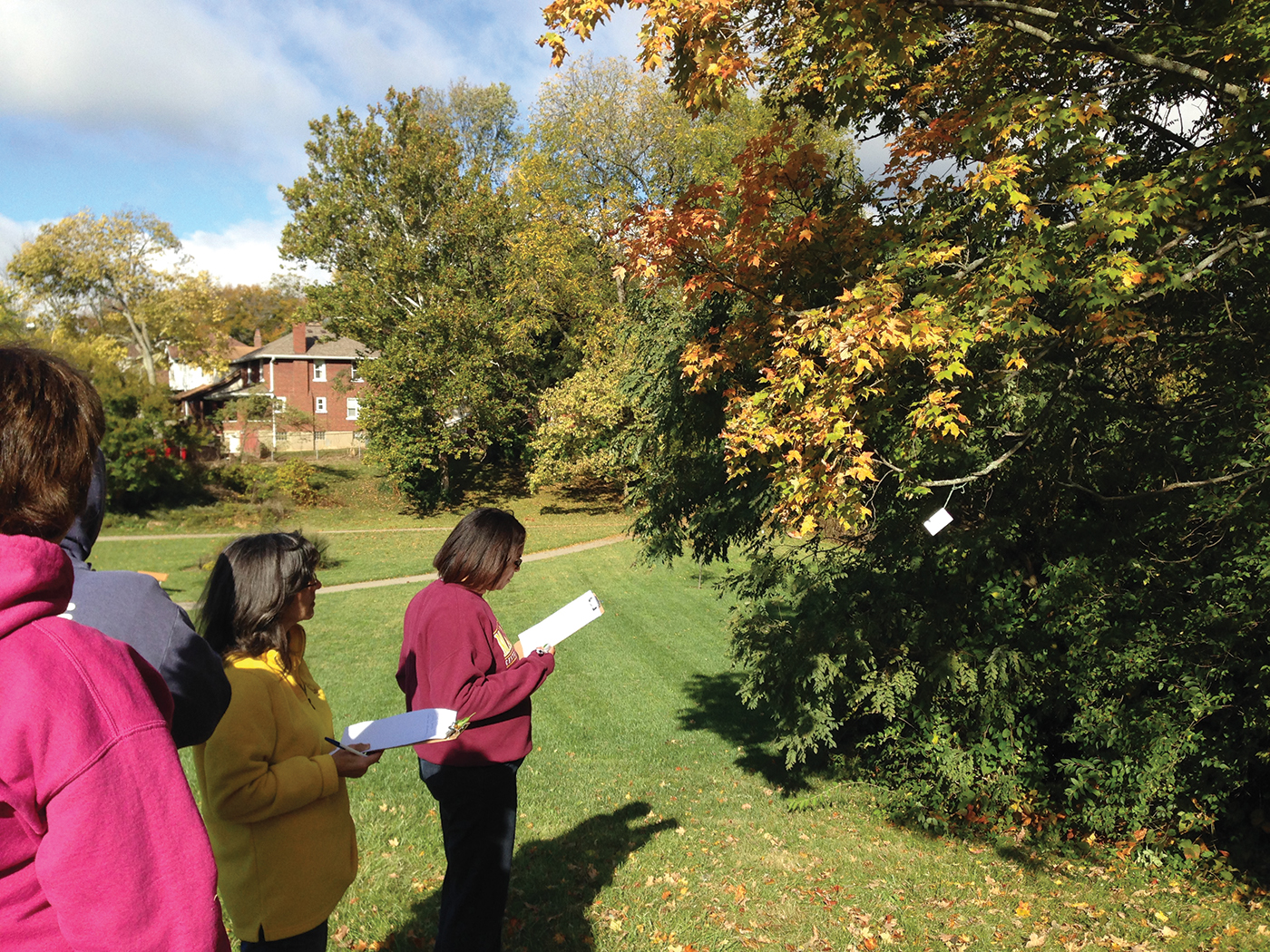Teaching Teachers
Create Engaging Workshop Experiences in Five Simple Steps
Create Engaging Workshop Experiences in Five Simple Steps
By Mary Dudley and Abby Strietmann
All educators, whether recently graduated or with years of experience, deserve opportunities to enhance their professional learning. Professional development offerings should be of the highest quality to maximize the time and resources invested. Research supports a blended model of traditional and nontraditional methods to increase the effectiveness of teacher trainings (Bayar 2014). The professional development workshops we provide are designed to meet the needs of educators, both in structure and content, and thus initiate, sustain, and strengthen our relationships with them.
Based on our experience with facilitating school garden and environmental education workshops with teachers, we have developed five steps each facilitator should include to host a productive and engaging professional development event. We hope those new to the field will build upon our experiences and that veteran trainers will enjoy this fresh take on the basics. While some specific references are made to the theme of school gardens, the general principles presented here are applicable to a wide range of professional development topics. Each step is described in detail below. We are excited to share our strategies with you and welcome your input.
Step 1: Identify Your Topic
Finding out what teachers need to be successful requires a continuous series of conversations between educators, administrators, and community members. Professional development offerings need to keep pace with teacher needs and district policies, which evolve from year to year. Involving the teachers in the planning phase instills a sense of ownership and brings practical application to the forefront (Forward 2011). Often, the identified need will include more than just content for students. Quality workshops incorporate information on how to acquire resources and pair them with appropriate classroom management techniques (Greene et al. 2013). When a topic of need emerges from conversations with teachers, invite local organizations with existing resources to help (rather than inventing new materials). Enlist an instructor whose expertise will provide a quality experience for those attending the workshop. Collaborating with multiple organizations will strengthen your educational community.

From Our Experience
It is important for community organizations to invest time building relationships with teachers and school district staff. As these relationships grow and conversations occur, you can identify teacher needs and district initiatives. We also collaborate with local organizations who provide school support and student programs. This allows us to match teachers with experts and resources that meet their needs. We have built a strong network through the partnerships that have resulted from inviting outside presenters to our workshops. Before inviting another presenter, watch them teach or ask for feedback from those who have seen them in action. Observation is critical in understanding teaching style and level of expertise.
Step 2: Test Presentation Materials
Materials and techniques shared during professional development workshops should be tested several times with student populations similar to those taught by the teachers attending your workshops. This enables the workshop facilitator to provide a preview of possible complications that may arise along with tested solutions. Always consider safety first when planning to test a student lesson. Have all necessary safety equipment (eye protection and hand protection) on site. Being aware of all the components of your workshop presentation, especially resources intended to be applied in the classroom, will prepare you to speak from experience. Any technology and tools that are used for student lessons should be rigorously reviewed and tested. Consider whether technology is necessary or if it could hinder student achievement in the event of incompatibility or other technical difficulty.
From Our Experience
Our teaching philosophy is built upon our understanding of how most audiences, adults and children alike, crave authentic experiences that occur when we interact with each other and the environment. Always put safety first and visit outdoor areas prior to student lessons to remove potential hazards. Our student lessons incorporate hands-on experiences in the garden such as moving soil, turning compost, or planting seeds and are tested by hundreds of students before being presented at our workshops. This trial period allows us to gain experience with the multitude of variables that can occur when working outdoors with students. We give teachers attending our workshops advice on what to do in challenging weather, how to manage noise pollution, and when to invite adult volunteers.
Our program design is guided by seasonal environmental conditions, school district policies, student and teacher need, state standards and Next Generation Science Standards, and the public school schedule. For example, during the fall season, a school district we work with launched an environmental science initiative that suggested covering the topic of environmental change in fourth grade. At that time, many of our plants were producing seeds, so we created a seasonally relevant lesson centered on seed dispersal that met NGSS 4-LS1-1: Construct an argument that plants and animals have internal and external structures that function to support survival, growth, behavior and reproduction. During this lesson students observed the physical characteristics associated with various seeds, explored the concept of dispersal mechanisms through a design challenge, and finally applied practical skills to harvest seeds from sunflowers and bean plants in the garden. After offering this lesson to numerous classes and making revisions based on teacher feedback, student input and facilitator reflection, it was presented as one component of our Incorporating Standards and Scientific Inquiry to Garden Education workshop.
Step 3: Workshop Logistics
Here is a list of the tasks you will need to complete as you work through logistics:
- Set the date and time. Remember that dismissal times and vacation days may vary from school to school, and consider how a weekend offering may affect other events.
- Choose a venue for the workshop. If you require electricity or access to a sink be sure to communicate those needs with the administrator of the facility prior to choosing a venue. Visit the venue before the workshop to ensure it meets all safety protocols and equipment needed (e.g., eye wash station, shower, outdoor area free of hazards).
- Determine the registration process. Will you require preregistration or allow walk-ins? Will you charge a fee for the workshop?
- Advertise your workshop. Consider flyers, emails, and website postings.
- Provide continuing education units. Research state requirements for offering continuing education units to teachers who attend. It may be as simple as providing a certificate with the title of the workshop and number of hours spent in training.
- Draft an agenda. Consider the time needed to present the material and include a segment at the beginning for introductions and a question-and-answer session at the end.
- Organize materials for teachers to take away. We strive to always give teachers a small materials kit (e.g., copies of seasonal garden lessons and windowsill salad garden kits with seeds, soil, and pots) to take back to class that pertains to the material presented during the workshop.
- Email details. Provide logistics on parking, appropriate clothing, and whether attendees ought to bring lunch or other items.
From Our Experience
We offer workshops on weekends and weekday afternoons to accommodate different school schedules. We work hard to find donors and grants that will support our workshops so we are able to provide them free of charge. We ask that teachers preregister so we have enough seats and kits available, but we also encourage walk-ins so everyone feels welcome. We post our upcoming workshops on our website and send monthly reminders to our email distribution list. In an effort to accommodate different learning styles and teacher schedules we offer three workshop models: formal seven-hour workshops that blend didactic lecture and hands-on experiences with a heavy focus on understanding gardening basics, casual 90-minute workshops that focus on collaboration and networking, and hands-on 60 minute workshops that walk teachers through a specific science lesson (see Figures 1 and 2 for sample agendas).


Step 4: Conduct the Workshop
Head into the workshop as prepared as possible, and stick to your agenda. Start on time and allow for a question-and-answer session. Most of all, make it fun! Begin by having participants introduce themselves. This sets a casual tone to the workshop and opens up opportunities for networking and collaboration. Set up a “parking lot” for teacher inquiries that aren’t directly related to the topic you are covering. This allows you to address questions at a later time or use them as focus areas for future workshops. Teachers should leave a workshop session with an increased comfort level in the content area, new connections among other educators, plans for implementing the presented material in their classrooms, and support from the facilitator should they have additional questions. The time spent during the workshop is just the beginning of a long-term partnership. Sending participants home with a materials kit will encourage implementation of the lessons presented.

From Our Experience
Give participants breaks and provide light snacks. Dial back the didactic lecture and include opportunities for group discussion and collaboration. Teachers enjoy hands-on activities and time spent making original products versus listening to a one-sided presentation (Forward 2011). Have blank paper and a clipboard handy to make notes on specific areas of participants’ interest that aren’t covered in-depth. Also, keep notes on the presentation so you can draft an outline to distribute in a follow-up email. We typically reserve the use of technology until after the workshop, as we link teachers to relevant blog postings and websites and reduce the chance of interrupting a productive workshop with technical difficulties.
Step 5: Provide Continuing Support
Contacting participants after the workshop encourages reflection and leads to the creation of enduring relationships. As you converse with participants, have open and honest communication about the amount of support you are able to provide and direct them to local organizations that can provide additional resources. These conversations build a relationship of trust that contributes to the lasting impact of the workshop and elevates the experience from a potentially ineffective “one off” event to one with sustained impact on teacher quality and student achievement (Forward 2011). Request feedback to assess the workshop and revise your agenda and materials for future workshops. Ask participants such questions as: “What factors make a professional development experience effective?” “What makes you walk away from a professional development experience feeling confident and supported?” “What improvements could be made to the workshop you experienced?” “Did you use or review the lessons provided? What feedback do you have to share?”
From Our Experience
Ideally, the workshop ends on a positive note, with everyone energized and excited to implement the ideas presented. Follow-up emails give you better insight on whether the workshop had any impact once the teachers return to the classroom. Most teachers in our workshops cite the connection with other teachers and the sharing of ideas and strategies as the most valuable aspects of the experience. Teachers appreciate materials they can implement “right away” and are “directly applicable” to their classroom curriculum. After each workshop, we consolidate a list of resources into a brief outline that we attach to a follow-up email and also post on our website. This creates a reference for future inquiries on that topic. We update these outlines regularly to ensure all website links are active and that we are presenting information that is relevant to our network.
Conclusion
We have found that the level of teacher comfort with the outdoors is the deciding factor for successful school gardens and positive outdoor experiences for students. Through on-site modeling and professional development offerings, we create opportunities for teachers to build comfort and confidence using nature to cover scientific content areas. We encourage all teacher trainers to break the mold of the traditional lecture and create fun, authentic, and memorable experiences. Give teachers the chance to dream big and learn something that enriches their personal lives as well as their professional content areas. Provide follow-up support. We can construct a better world for our children and it starts with empowering teachers.


